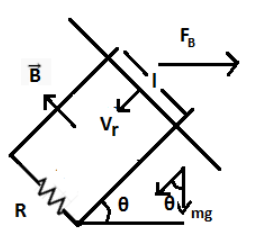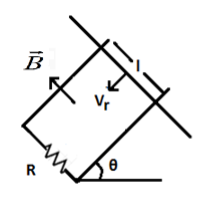
Answer
450.9k+ views
Hint: Here, the copper rod is sliding under gravity. Due to the applied magnetic field, a force will be acting on the rod, and this force is proportional to the current in through the rod, its length, the applied magnetic field and the angle between magnetic field and copper rod. And a motional emf is also induced in the rod, which is proportional to the velocity of the conductor.
Formula used:
\[{{F}_{B}}=ilB\sin \theta \]
\[I=\dfrac{V}{R}\]
\[e=Bl{{v}_{T}}\]
Complete answer:

We have,
\[{{F}_{B}}=ilB\sin \theta \]
Where,
\[i\] is the current
\[l\] is the length of the conductor
\[B\] is the magnetic field
\[\theta \] is the angle between the rod and the magnetic field.
Here, magnetic field is acting perpendicular on the rod, \[\theta =90\]
Then,
Force,\[{{F}_{B}}=ilB\]
The force due to gravity is also acting downwards. Then, equating the horizontal component of forces at equilibrium,
\[mg\sin \theta -ilB=0\Rightarrow mg\sin \theta =ilB\] ---------- 1
We know that,
\[I=\dfrac{V}{R}\] -------------- 2
Where,
\[V\] is potential
\[R\] is resistance
Here, due the magnetic field, an emf is induced in the rod, then, potential will be equal to the induced emf.
\[V=e\]
Then, equation 2 becomes,
\[I=\dfrac{e}{R}\]
Substitute the above equation, in 1, we get,
\[mg\sin \theta =\dfrac{e}{R}lB\] ----------- 3
Since, the rod reached its terminal velocity, motional emf will be,
\[e=Bl{{v}_{T}}\]
Where,
\[{{v}_{T}}\]is the terminal velocity
Then,
Equation 3 becomes,
\[mg\sin \theta =\dfrac{Bl{{v}_{T}}}{R}\left( Bl \right)\Rightarrow {{v}_{T}}=\dfrac{\left( mg\sin \theta \right)R}{{{B}^{2}}{{l}^{2}}}\]
Therefore, the answer is option B.
Note:
Terminal velocity is a steady speed achieved by an object freely falling through a liquid or gas. An object released from rest will increase its speed until it attains the terminal velocity. When an object is forced to move faster than its terminal velocity, it will slow down to this constant velocity upon releasing.
Formula used:
\[{{F}_{B}}=ilB\sin \theta \]
\[I=\dfrac{V}{R}\]
\[e=Bl{{v}_{T}}\]
Complete answer:

We have,
\[{{F}_{B}}=ilB\sin \theta \]
Where,
\[i\] is the current
\[l\] is the length of the conductor
\[B\] is the magnetic field
\[\theta \] is the angle between the rod and the magnetic field.
Here, magnetic field is acting perpendicular on the rod, \[\theta =90\]
Then,
Force,\[{{F}_{B}}=ilB\]
The force due to gravity is also acting downwards. Then, equating the horizontal component of forces at equilibrium,
\[mg\sin \theta -ilB=0\Rightarrow mg\sin \theta =ilB\] ---------- 1
We know that,
\[I=\dfrac{V}{R}\] -------------- 2
Where,
\[V\] is potential
\[R\] is resistance
Here, due the magnetic field, an emf is induced in the rod, then, potential will be equal to the induced emf.
\[V=e\]
Then, equation 2 becomes,
\[I=\dfrac{e}{R}\]
Substitute the above equation, in 1, we get,
\[mg\sin \theta =\dfrac{e}{R}lB\] ----------- 3
Since, the rod reached its terminal velocity, motional emf will be,
\[e=Bl{{v}_{T}}\]
Where,
\[{{v}_{T}}\]is the terminal velocity
Then,
Equation 3 becomes,
\[mg\sin \theta =\dfrac{Bl{{v}_{T}}}{R}\left( Bl \right)\Rightarrow {{v}_{T}}=\dfrac{\left( mg\sin \theta \right)R}{{{B}^{2}}{{l}^{2}}}\]
Therefore, the answer is option B.
Note:
Terminal velocity is a steady speed achieved by an object freely falling through a liquid or gas. An object released from rest will increase its speed until it attains the terminal velocity. When an object is forced to move faster than its terminal velocity, it will slow down to this constant velocity upon releasing.
Recently Updated Pages
Fill in the blanks with suitable prepositions Break class 10 english CBSE

Fill in the blanks with suitable articles Tribune is class 10 english CBSE

Rearrange the following words and phrases to form a class 10 english CBSE

Select the opposite of the given word Permit aGive class 10 english CBSE

Fill in the blank with the most appropriate option class 10 english CBSE

Some places have oneline notices Which option is a class 10 english CBSE

Trending doubts
Fill the blanks with the suitable prepositions 1 The class 9 english CBSE

How do you graph the function fx 4x class 9 maths CBSE

When was Karauli Praja Mandal established 11934 21936 class 10 social science CBSE

Which are the Top 10 Largest Countries of the World?

What is the definite integral of zero a constant b class 12 maths CBSE

Why is steel more elastic than rubber class 11 physics CBSE

Distinguish between the following Ferrous and nonferrous class 9 social science CBSE

The Equation xxx + 2 is Satisfied when x is Equal to Class 10 Maths

Differentiate between homogeneous and heterogeneous class 12 chemistry CBSE





